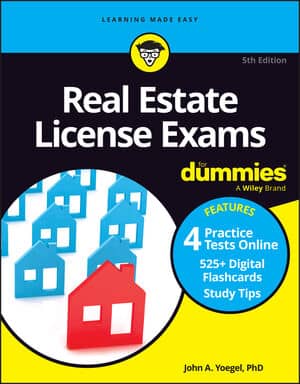The Real Estate License Exam will ask questions about funding mortgages. One of the important pieces of information that a real estate agent can provide a buyer is where to go for a mortgage loan, but oddly enough, it isn’t something that exam writers ask questions about beyond distinguishing between the primary and secondary mortgage markets.
The primary market is composed of the lenders who lend money to people who want to buy property. The primary market is where you go to get a mortgage loan. The secondary market is composed of financial institutions to which the banks sell the mortgages to get more money to lend to you.
As you get into who provides the money for mortgage loans, you need to understand a few terms because they relate as much to where you get the money as they do to the terms of the loan itself.
The terms relative to mortgage loans — conventional, conforming, and nonconforming — relate to the down payment, which is the cash you put into the purchase of the property, and the qualifying ratios the banks use, which are the amounts of money they think you can afford to pay for a mortgage loan.
These terms further relate to whether the lender (primary market) can sell the mortgage to the secondary market. One thing you should note: The lender and the primary mortgage market is the same thing.
Conventional loan: These loans meet certain guidelines that can be set by the lender but often comply with standards set by Fannie Mae in the secondary mortgage market. The general terms are that the total amount of the loan won’t exceed certain limits and typically that the borrower can borrow no more than 80 percent of the value of the property involved — although higher limits are possible.
Conventional loans essentially are loans made within normal guidelines by lenders in the primary mortgage market.
Conforming loan: This loan meets the criteria necessary for it to be sold in the secondary mortgage market. The way conforming loans are set has to do with the amount of money the borrower can spend on monthly payments.
Nonconforming loan: Here’s a loan that doesn’t meet the criteria of the secondary mortgage market. These loans may be made by lenders under specific circumstances and may include extra requirements that the borrower must meet, but they cannot be sold on the secondary mortgage market.
How this works is that Fannie Mae, for example, sets a guideline that says a borrower can spend no more than 28 percent of his or her monthly income on the mortgage payment, taxes, and insurance.
If the lender (primary market) chooses to lend an amount of money that requires the borrower to use 30 percent of his or her monthly income for those payments, the lender has just made a nonconforming loan that cannot be sold to Fannie Mae (secondary market); however, it may be sold to private investors who buy mortgages for the income from the interest payments that they generate.

